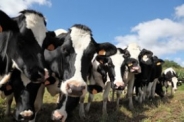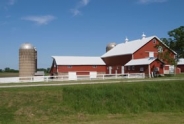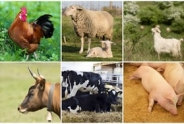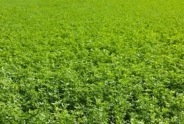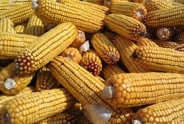When does it make sense for a livestock farm to grow annual forages?
Kitty O'Neil, Team Leader, Field Crops & Soils Specialist
North Country Regional Ag Team
Each year, Extension staff across NYS get lots of questions about using annual crops for grazing or making stored feed for livestock. During a spring with extreme weather, we field even more inquiries than normal as farms try to adapt. Though mixes of perennial native and improved grasses and legumes are the mainstay for grazing livestock, there are some important benefits of fitting an annual forage into the plan, in some situations, for some farms. This article outlines a few reasons why NYS livestock farms that normally rely on perennial forages may want to consider planting or rotating annual forage crops on some of their acres. The converse is also important - annual forages are not always an ideal alternative. Some of those considerations are also listed here.
Annual forage species generally fit into one of three main categories: 1) cool-season, winter-hardy annuals (winter wheat, triticale, cereal rye), 2) cool-season, not winter-hardy annuals (oats, crimson clover, brassicas) and 3) warm-season, summer annuals (sorghum sudangrass, corn, soybean, buckwheat, cowpea). Winter hardiness depends on the severity of winter where crops are grown as well as the life cycle tendencies for a plant species. Cool-season perennial grasses (timothy, orchardgrass, bromegrass) and legumes (alfalfa, red and white clovers, birdsfoot trefoil), on the other hand, can persist for multiple growing seasons and survive our Northeast winters reliably...most of the time.
Reasons to plant summer annual forage crops are numerous.
Combat the summer slump. Here in the Northeast, we typically use cool season perennial grasses and legumes, such as orchardgrass, timothy, alfalfa and clovers, for pasture, for dry hay and fermented feeds. Cool season forages, as a group, yield well in the spring and fall but their growth during the warmest part of the season is often referred to as the 'summer slump' due to their sluggish productivity. Our grazing operations occasionally struggle to keep up with highly productive grasses and legumes in the spring, risk overgrazing that limited growth during the warmest weeks of July and August before having better yields again in the late summer and early fall. Annual forages like corn, brown midrib sorghum-sudangrass (BMR SxS), pearl millet or teff, are warm season grasses. These species respond well to warm or hot temperatures with growth and yield. These warm season forages can help to bridge the herd or flock through that low yielding, hot portion of the summer because these summer annuals like the heat and produce big yields while cool season forages take a siesta. Put another way, warm season annual forages can help manage the risk of too little cool season forage during the warmest part of the season.
Rotate out old, declining stands or pugged up sacrifice areas. Some farms use a year of annual forage as a steppingstone to rotate out of a damaged or declining stand of grass and legumes and then back to fresh new perennial forage seeding. Annual forage selections may be planted with tillage or no-till methods, in spring or fall. Use of tillage can also provide an opportunity for lime to be tilled into the soil for faster pH correction, incorporation of fertilizers, disruption of some perennial weeds and other pest cycles, and alleviation of ruts or rough surfaces with targeted smoothing.
When grain prices rise or nutritional requirements demand higher energy or protein feeds. While standard perennial mixed grass-legume stands can be higher in digestibility than annual forages, they sometimes do not yield enough energy or protein at the right time of year for optimal breeding or for finishing livestock quickly enough or for a high quality grade. Additionally, high grain costs can sometimes make homegrown energy and protein appealing. In these situations, it may make sense to consider adding corn or a small grain or soybeans to a cropping plan. Additionally, while grass-finishing stipulations usually don't permit feeding grains, some annual crops can yield more energy per acre, more fattening potential per acre, than a perennial forage, especially during the summer or late in the season - if they are grazed or harvested before grain develops to meet grass-fed market requirements. While some of these annual options may make economic sense when grain prices are high, it is important to "push a pencil" to calculate their true cost to the farm, considering both finances and realistic land, labor, and equipment resources.
Use as an 'emergency forage' when weather delays or other forage failures arise. Some springs are wet enough to delay planting until after the recommended window for spring perennial forage seedings has passed. Here in NNY, perennial forage fields or pastures can be seriously damaged by extreme winter temperatures, drought stress or insect damage, but the timing of this discovery can be wrong for immediate replacement with another perennial forage seeding. This year, perennial forage seeds are in very tight supply and some may not be available or may be extra costly. A summer annual forage planting can rescue some of these unusual situations.
Though summer annual forages may be a distinct advantage over continuing an established perennial stand in some situations, they can also create more headaches than keeping a perennial forage field.
Annual crop seed and input purchases can be more expensive. Input costs per acre per year over the life of a perennial forage stand tend to be lower than for an annual forage crop. The increased yield and quality potential of the annual forage may make this investment in seed, herbicide, fuel and labor worthwhile, but it will typically require a bigger annual cost. This spring, supplies of perennial forage seeds are expected to be extraordinarily tight, which may increase their cost, possibly making annual forages a bit more appealing.
Timely planting. As a group, annual forages provide more planting date flexibility than perennial forages, but each species should be planted on time for best outcomes and economic return. See the 'Emergency and Alternative Summer Annual Forages' factsheet linked at the end of this article for detailed planting and management recommendations for 9+ different annual forage species with recommended planting dates ranging from early spring to late summer.
A terminated, open field is a risk. Once a field is terminated, good soil conditions are needed for timely preparation and planting of the next crop and for the annual crop to emerge and grow to grazable or harvestable stages. Sometimes, wet weather can cause planting delays and complications. Other times, the neighbor's borrowed grain drill doesn't function as expected and requires time and effort to adjust or repair. In the worst scenario, bad weather lingers and the planting window comes and goes before the planting can be completed as planned. While the field is open, weeds can become established, erosion may occur and no useful forage is available from that field. Planting experience and reliable equipment can minimize these risks, but cannot eliminate weather delays.
Annual crops do not belong on some perennial pasture and hay land. Here in the Northeast, we tend to use more marginal land, soils and fields for grazing and hay production. Some pastures are too steep, stony, poorly drained or wooded for annual crops to be a viable option. Our hay fields typically offer better potential, but some are too poorly drained to be good candidates for annual cropping. Those unsuitable fields should be managed to keep perennial stands as healthy and productive as possible in the long term with good pH and fertility, harvest and mowing practices.
Once the decision to add an annual forage to a livestock system has been made, select a species or mixture based on seed availability, soil moisture status, timing within the growing season, any carryover of herbicide treatments, the nutritional needs of the animal group it will feed and the farm's harvest and storage methods (dry hay, silage, baleage or grazing).
Like all decisions among numerous alternatives, care and consideration is required to make a good choice. Some annual forage species are well-suited to baling dry hay while others should be grazed or fermented for silage or baleage. Some are only good for grazing and not well-suited for harvest of any kind. Some forages will work better in large round bales if they are roto-cut or net-wrapped. Choose a species or mixture that is a good fit for the climate and soil types in the field under consideration. A few warm season species can tolerate moderate drought, though any new planting will require at least some soil moisture for germination and establishment. Some annual species can better tolerate poor soil drainage or more acidic soils. The nutritional requirements of the herd or flock should a main driver of species and mixture selections too. Grass-finished beef or lamb or a milking dairy herd needs higher digestibility forages than animals at maintenance, but different annual species can be used to suit a range of forage quality requirements.
Additional Resources:
Thomas-Murphy, J, et al. 2021. Cornell Guide for Integrated Field Crop Management. Cornell University.
O'Neil, K., M. Hunter, J. Cherney, J. Lawrence, T. Kilcer, T. Bjorkman, and Q. Ketterings. 2020. Agronomy Fact Sheet # 114: Emergency and Alternative Summer Annual Forages. Nutrient Management Spear Program, Cornell University. http://nmsp.cals.cornell.edu/publications/factsheets/factsheet114.pdf
Announcements
No announcements at this time.

